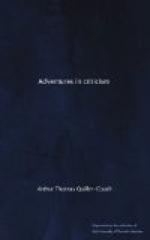“O pale, pale now, those
rosy lips
I aft hae
kissed sae fondly!
And closed for aye the
sparkling glance
That dwelt
on me sae kindly!
And mouldering now in
silent dust
The heart
that lo’ed me dearly—
But still within my
bosom’s core
Shall live
my Highland Mary.”
Or,
“Had we never loved
sae kindly,
Had we never
loved sae blindly,
Never met—or
never parted,
We had ne’er
been broken-hearted.”
Scott left an enormous mass of writing behind him, and almost all of it is good. Burns left very much less, and among it a surprising amount of inferior stuff. But such pathos as the above Scott cannot touch. I can understand the man who holds that these deeps of pathos should not be probed in literature: and am not sure that I wholly disagree with him. The question certainly is discutable and worth discussing. But such pathos, at any rate, is immensely popular: and perhaps this will account for the hold which Burns retains on the affections of a race which has a right to be at least thrice as proud of Scott.
However, if Burns is honored at the feast, Scott is read by the fireside. Hardly have the rich Dryburgh and Border editions issued from the press before Messrs. Archibald Constable and Co. are bringing out their reprint of the famous 48-volume edition of the Novels; and Mr. Barrie is supposed to be meditating another, with introductory notes of his own upon each Novel. In my own opinion nothing has ever beaten, or come near to beat, the 48-volume “Waverley” of 1829; and Messrs. Constable and Co. were happily inspired when they decided to make this the basis of their new edition. They have improved upon it in two respects. The paper is lighter and better. And each novel is kept within its own covers, whereas in the old editions a volume would contain the end of one novel and beginning of another. The original illustrations, by Wilkie, Landseer, Leslie, Stanfield, Bonington, and the rest, have been retained, in order to make the reprint complete. But this seems to me a pity; for a number of them were bad to begin with, and will be worse than ever now, being reproduced (as I understand) from impressions of the original plates. To do without illustrations were a counsel of perfection. But now that the novels have become historical, surely it were better to illustrate them with authentic portraits of Scott, pictures of scenery, facsimiles of MSS., and so on, than with (e.g.) a worn reproduction of what Mr. F.P. Stephanoff thought that Flora Mac-Ivor looked like while playing the harp and introducing a few irregular strains which harmonized well with the distant waterfall and the soft sigh of the evening breeze in the rustling leaves of an aspen which overhung the fair harpress—especially as F.P. Stephanoff does not seem to have known the difference between an aspen and a birch.




